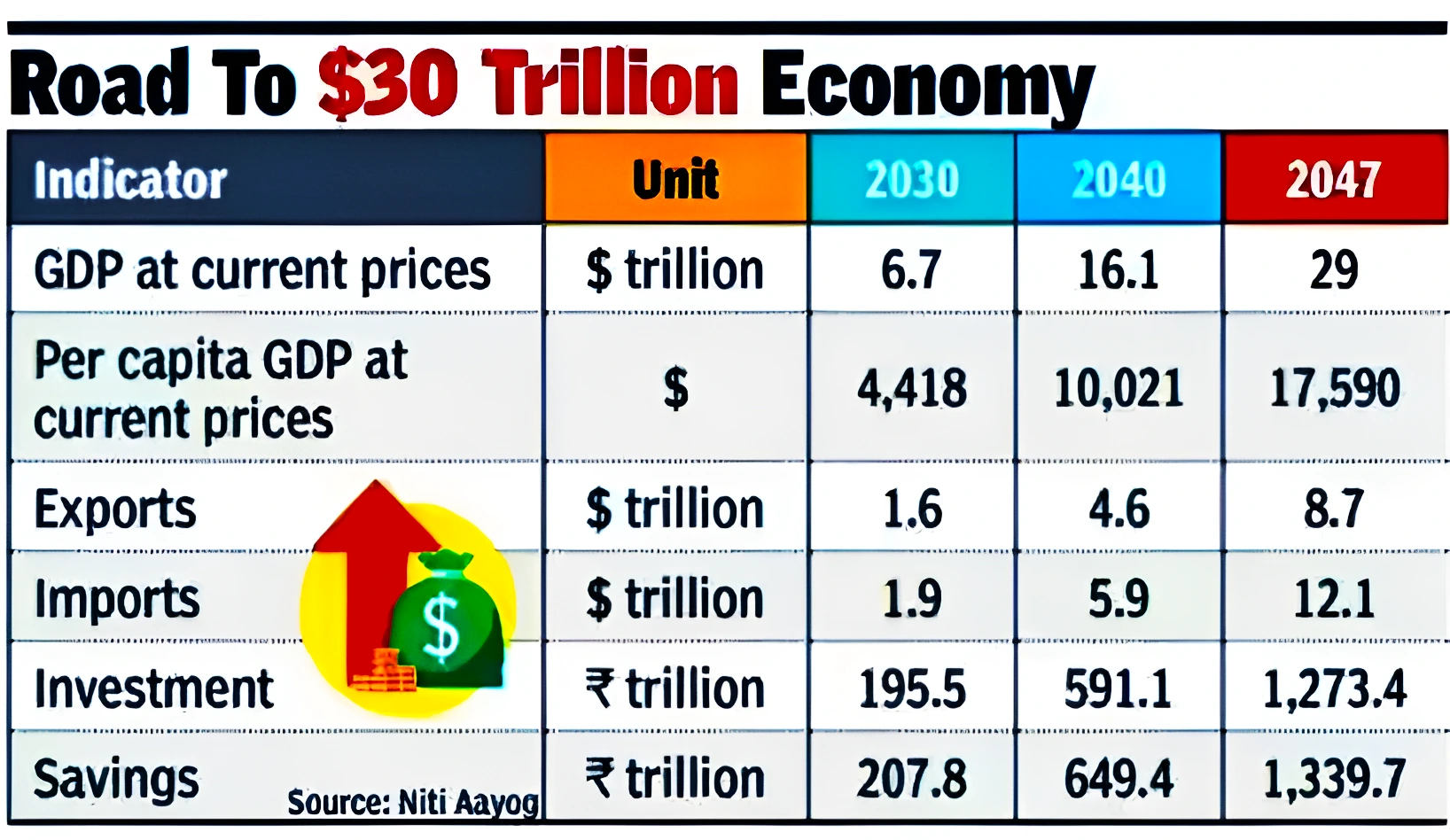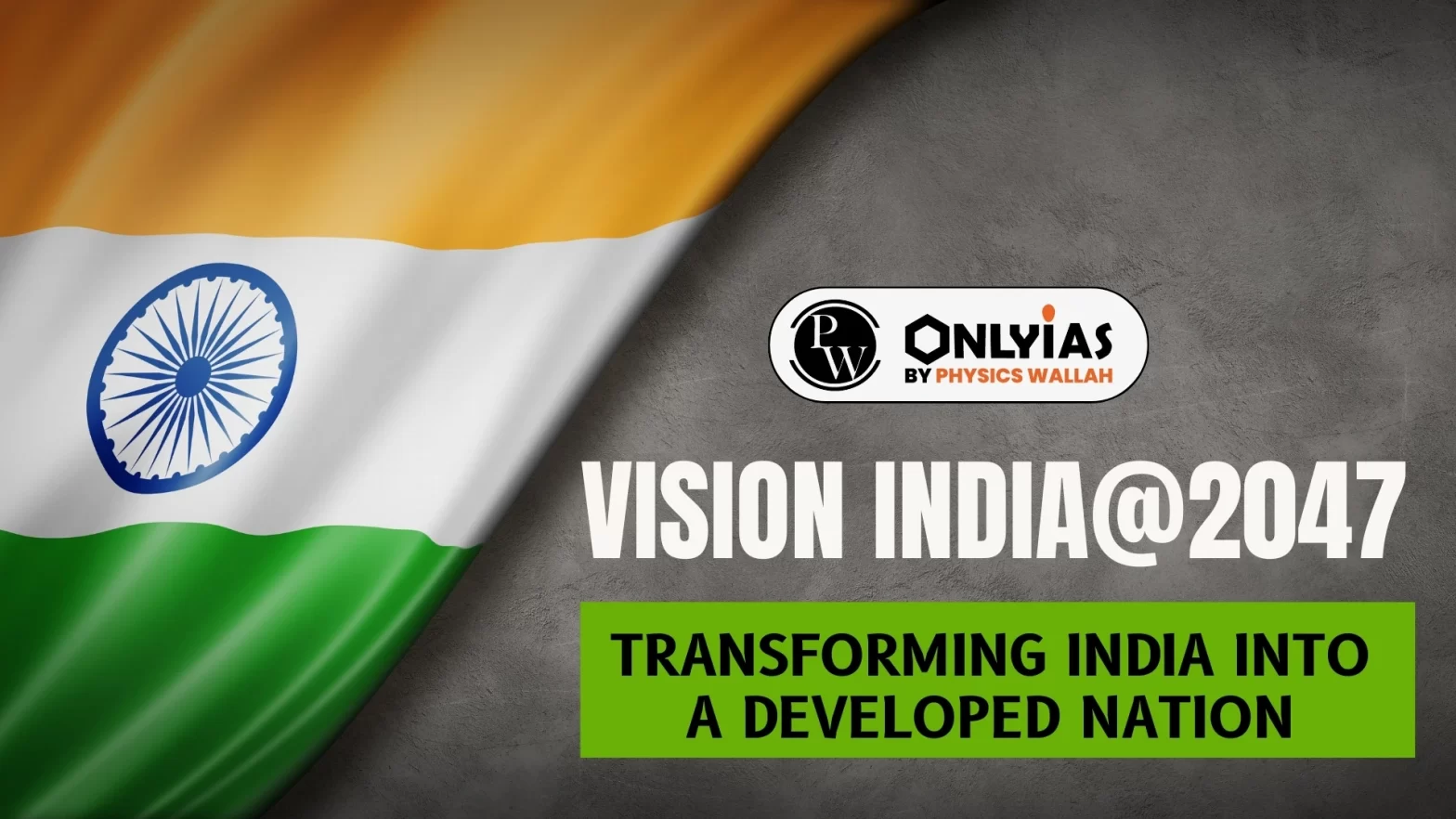Context: This article is based on the news “Global equations have a symbolic role in building a developed India by 2047” which was published in the Live Mint. In early 2024, the Indian Prime Minister is expected to unveil the Vision India@2047 document to transform India into a developed nation with a $30 trillion economy by 2047.
| Relevancy for Prelims: Vision India@2047 document, Amrit Kaal, NITI Aayog, and 2024 Asia-Pacific Human Development Report.
Relevancy for Mains: Vision India@2047: India’s Economic Aspirations for 2047: Challenges, and Way Forward. |
Vision India@2047: India’s Economic Aspirations for 2047
- India’s Economic Growth: India’s rise from 1991, when it accounted for 1.1% of the global economic output, to 3.5% and currently as the world’s fifth largest economy, has been driven by reforms and liberalization agenda.
- Further, India is aiming for a 9% growth rate between 2030 and 2047.
- Rising India’s Importance: India is a critical player in almost every major issue facing the planet.
- The Ukraine crisis has shown that great powers are desperate to count on India as an ally.
- Further, there will be no successful solution to climate change without India.
- Need for Vision India@2047 Document: This Vision India@2047 document is under development to ensure that India does not slip into a middle-income trap in the future.
What is Vision India@2047?
- Vision India@2047 Document: Vision India@2047 will cover government process re-engineering, global engagement, implementation roadmaps, and measures to avoid the middle-income trap.
- The document will also include plans for creating global leaders, addressing regional disparities, and developing human capital.
- Middle-Income trap: According to the World Bank, the middle-income trap refers to a situation whereby a middle-income country is failing to transition to a high-income economy due to rising costs and declining competitiveness.
- Formulation: The strategy for achieving the objective was started in December 2021 and is being prepared by NITI Aayog.
 Major Themes for 2047: These include infrastructure, welfare, commerce and industry, technology, and governance.
Major Themes for 2047: These include infrastructure, welfare, commerce and industry, technology, and governance.- Adaptability: This document will outline the necessary changes and reforms to achieve the goal.
- Timeframe: The Vision India@2047 document has action points and outcome goals into two periods viz. 2030, and the 17 year-period from then till 2047.
- Opinions: The NITI Aayog will soon share its central ideas and goals past top minds including World Bank President, Apple chief, as well as Indian industrialists and thought leaders, to make it more better.
Continue Reading: Viksit Bharat @2047: Voice Of Youth Workshop
About Amrit Kaal
- Era of Elixir: The Prime Minister of India introduced the concept of Amrit Kaal or ‘The Era of Elixir’ to the entire nation on India’s 75th Independence Day.
- New India: Amrit Kaal is the Vision India@2047 for ‘New India’, a new dawn for the country which will bring with it the chance to fulfill the nation’s aspirations.
- Objective: To restructure all fragments of the Indian economy through rapid profitable growth, better living conditions for all, infrastructural and technological advancements, and re-awakening the world’s trust in India.
|
What are the Strengths of India?
- Significant Demographic Dividend: India is home to more than 600 million people aged between 18 and 35, with 65% under the age of 35.
- India’s demographic dividend is expected to persist until 2055–56 and peak around 2041.
- Vibrant Democracy: India is the largest democracy in the world with a population of around 1.44 billion people, of which around 945 million voters.
- In a world where big and small nations are breaking into micro-entities, India has demonstrated its inherent resilience. This strength comes from its composite culture, making India a vibrant democracy.
- Resilient Economy: Resilient economies are flexible at both macro and micro levels, and there is abundant evidence that the Indian economy has become more resilient since liberalization 30 years ago.
- The multiple shocks suffered by the global economy in the last 15 years have generated considerable international discussion of resilience. India’s rapid post-COVID recovery also provides some encouraging pointers.
- NITI Aayog has forecasted that India’s economy will be worth $30 trillion in 2047, with a per capita GDP of $17,590.
- According to the World Bank’s latest India Development Update (IDU), India was one of the fastest-growing major economies in FY22/23 at 7.2% despite significant global challenges.
- Diplomacy: In this digital age, it becomes important for countries like India to employ public diplomacy as a responsible power.
- India is adopting a public diplomacy policy that can effectively communicate the nation’s story to foreign audiences.
- India was ranked 28th in the Global Soft Power Index 2023 report making it the second year in which the country has featured in the top 30 countries.
- According to the State of Southeast Asia Survey 2023, India has also gained trust among the ASEAN countries, recording an improvement in trust ratings from 16% in 2022 to 25% in 2023.
- Bloomberg has also highlighted India’s soft power, reinforced through the country hosting the G20 and SCO in 2023.
- Sustainable and Inclusive Development: Over the last decade, India has been a frontline contributor to the fight against climate change and has surfaced as a global economic power.
- For instance, at the COP26 summit, India committed that it would achieve ‘net zero’ carbon emissions by 2070.
- The launch of ‘Mission LiFE’- Lifestyle for Environment, further pushed all Indian citizens to come forward and take steps towards an environmentally conscious life setting.
- New India also professes equality of all genders with the nation’s leaders promoting equal participation and representation of women at all workplaces by providing them fair and equal opportunities and ensuring their upliftment through various schemes and programs such as ‘Beti Bachao Beti Padhao’.
- Technology and Innovation: India is making advances in healthcare not only through infrastructure development but also by employing Artificial Intelligence (AI) to its best use.
- The use of AI in agriculture has proved to be a game-changer with over 7000 farmers using AI to monitor the health of their crops, control quality and test their yield.
- A robust digital public infrastructure (DPI), comprising distinctive digital identification, a payments system (Unified Payments Interface), and a data exchange layer, is significant for driving economic transformation and fostering inclusive growth.
What are the Challenges Faced by India?
- Lack of Inclusivity: According to the 2024 Asia-Pacific Human Development Report, India has persistent disparity and widespread disruption.
- Amidst rapid growth but persistent disparity, the income distribution has become skewed.
- For instance, the top 10% of the population gets 57% of national income and the top 1% gets 22%.
- Various factors drive this persistent wealth divide. For example, globalization and technological advances have created new opportunities for some groups while leaving others behind.
- Further, the legacy issues are a high proportion of the non-agricultural labor force in the unorganized sector and the proportion of women’s time devoted to the care economy.
- Global Uncertainty: Shocks arising from geopolitical conflicts (Eg. Israel- Hamas conflict), structural changes like the energy transition, etc. will limit greater labor market flexibility and mobility. This has implications for everything from transport infrastructure to housing markets.
- Lack of Trade Openness: Protectionism in rich countries under the guise of environment leakage is an emerging risk, even as traditional supporters of a rules-based trading system are less interested in defending it.
- Further, India’s economy is expected to face constraints in FY 2023-24, with weak global demand and monetary policy tightening to manage inflationary pressures. This will limit real GDP growth to 6%.
- Breaking Lower Middle-Income Country Status: India continues to grow but this current trend growth will not be sufficient to reach its goals to reach middle-income and eventually high-income status.
- For instance, to become a middle-income country, India needs 80% high prosperity (measured at PPP terms) compared to where the country is today. It means a $7 trillion economy, 2.5 times the size of today.
- To become a high-income country, India would need to become a $60 trillion economy, 20 times the size of today.
- Other Challenges: Risks to positive GDP growth projections are predominantly hindered by challenges which include potential deterioration of banks’ asset quality, delays in fiscal consolidation, difficulties in trade agreements, and the impact of below-normal monsoon seasons, etc.
Way forward: Road Map for the Vision India@2047
- Harnessing Demographic Dividend: Efforts are needed to upskill millions of our working-age youth nationwide to make them industry-ready and future fit for the new sets of jobs that are being created owing to the disruption of existing business models.
- Acquiring relevant skill sets aligned to futuristic goods and services such as servicing robots, repairing augmented reality (AR)/virtual reality (VR) devices, and manufacturing chips would also be useful going forward.
- This goal may be achieved through close cooperation between private, public and civil society organizations. One district one skill (ODOS) could be a starting point, mirroring the one district one product (ODOP) scheme.
- Increase Spending in Education Sector: The Government spending in the education sector in India has been under 3.5% of the GDP, compared to a global mean of about 4.5% of the GDP. India needs a calibrated increase of the education sector’s budget from the current levels to match global levels with a focus on spending efficiency.
- The new National Education Policy (NEP) 2020 is an effort in this direction, and implementing this policy is the need of the hour.
- Further, the announcement of the Combined University Entrance Test (CUET) for admission to central universities instead of students’ admissions only on the basis of marks is a step in the right direction.
- Inclusive Growth: The labor force participation rate (LFPR) in India is around 40% compared to over 74% in Spain and around 75% in Portugal. The primary reason for this low LFPR is the absence of women from the workforce in India, which has a female LFPR of around 20%.
- Women earning and proactively participating in the workforce positively impact a family’s prosperity, can help eradicate poverty and strengthen the journey towards building a prosperous, safe and healthy India@2047.
- Unlocking Manufacturing Potential: India has been aspiring to grow its manufacturing sector to account for 25% of the economy from the current levels of around 15%. The recent supply chain shocks owing to the pandemic and fractured geopolitics present a unique opportunity to India to dominate this space.
-
- The Production Linked Incentive (PLI) scheme has been launched to benefit from this growth wave.
- Simultaneously, India needs to focus on new-age manufacturing in the areas of space, telecom, renewables and metaverse devices.
- The National Skill Development Mission should also work towards making such skills available for the new-age manufacturing sector.
Must Read: Periodic Labour Force Survey (PLFS) Annual Report 2022
Conclusion:
Vision India@2047 presents a comprehensive roadmap for transforming India into a developed nation with a $30 trillion economy, addressing challenges through strategic planning, inclusive growth, and harnessing the nation’s strengths for a prosperous future.

 Major Themes for 2047: These include infrastructure, welfare, commerce and industry, technology, and governance.
Major Themes for 2047: These include infrastructure, welfare, commerce and industry, technology, and governance.